Content
- 1 What do coconuts look like and where do they grow?
- 2 Vitamins and minerals in coconut
- 3 How many calories are in coconut
- 4 Useful properties of coconut
- 5 Can pregnant women eat coconut?
- 6 Is coconut allowed for breastfeeding
- 7 At what age can children take coconut
- 8 The benefits and harms of coconut for weight loss
- 9 Features of the use of coconut for diabetes and gastritis
- 10 Application of coconut
- 11 How and with what to eat coconut
- 12 How to break a coconut at home
- 13 Possible harm to coconut and contraindications
- 14 How to choose the right coconut in the store
- 15 How and where to store open coconut
- 16 Conclusion
Coconut is a tropical exotic, endowed with many useful properties. This "monkey", as soso is translated from Portuguese, is a representative of the Palm family. And because of the three spots on the fruit, it really resembles the face of this animal. And although our exotic nut is not as popular as in countries of constant sun and heat, the benefits and harms of coconut are increasingly attracting attention.
What do coconuts look like and where do they grow?
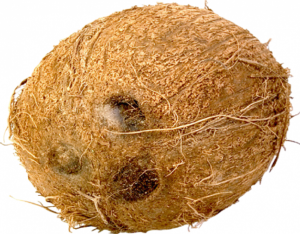
Coconut is the round, slightly elongated fruit of the coconut tree. Its length reaches 25-30 cm, and its weight is 2.5 kg. Coconut is usually considered a nut, which is considered a mistake. This is a drupe, the inner part of which is called the endocarp, and the outer part is called the exocarp. The flesh inside is 12 mm thick and liquid containing nutrients, starch and proteins. This water is called edosperm. As soon as the exotic begins to ripen, it is transparent and slightly cloudy. In a ripe fruit, the water acquires a yellowish tint and is saturated with oils. Mixing with the pulp, the water turns into coconut milk, which tastes sweet.
Sandy soil is best for coconut trees. The wild variety prefers the tropics. Palm trees grow in large numbers along the coastal strip of the Malacca Peninsula, Sri Lanka. The habitats of these trees include the Indian coasts and the Philippines. And in Indonesia, the processing and production of coconuts is the most developed, in which it ranks first.

Vitamins and minerals in coconut
The benefits and harms of coconut for the human body are being investigated by scientists. They claim that the composition of his water is similar to that of blood. Edosperm contains an amount of useful elements equal to that required for the body. Due to its rich composition, drupe can be used in many directions. It contains:
- amino acids;
- antioxidants;
- useful fiber;
- essential oils.
Exot boasts a rich vitamin composition.
For 100 g of the product there are:
|
Vitamin |
Quantity, mg |
|
IN 1 |
0,066 |
|
AT 2 |
0,02 |
|
AT 3 |
0,3 |
|
AT 6 |
0,054 |
|
AT 9 |
26 |
|
FROM |
3,3 |
|
E |
0,24 |
|
TO |
0,2 |
|
PP |
0,54 |
|
Choline |
12,1 |
The benefits of coconut for the body are enhanced by the composition rich in useful minerals:
|
Name |
Amount, mg per 100 g |
|
Potassium |
356 |
|
Calcium |
14 |
|
Magnesium |
32 |
|
Sodium |
20 |
|
Manganese |
1,5 |
|
Copper |
0,4 |
|
Selenium |
0,022 |
|
Phosphorus |
113 |
|
Iron |
2,43 |
|
Zinc |
1,1 |
Due to the rich content of drupe minerals in the water, it has beneficial properties for people who are engaged in vigorous activities and athletes, replacing sports drinks.
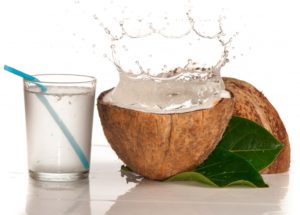
How many calories are in coconut
Coconut is a unique product. It is a high-calorie pulp and water that contains practically no calories.
Calorie content and nutritional value (BZHU):
|
Name |
In water, g |
In pulp, g |
|
Protein |
4 |
3,33 |
|
Fats |
27 |
33,49 |
|
Carbohydrates |
6 |
15,23 |
|
Calories |
360 |
16,7 |
The calorie content of a dry tropical delicacy is even higher than that of pulp.
It is 590 kcal per 100 g of product.
Useful properties of coconut
The health benefits and harms of coconut directly depend on the content of vitamins, minerals and nutrients in it. They are the main substances that are required for the proper functioning of the internal organs. For athletes, especially weightlifters, the benefits of coconut pulp are valuable. It is rich in proteins, the properties of which help to gain muscle mass faster, and a large number of calories saturates the body with energy. Coconut is an excellent remedy for people who want to gain weight without harming their health.
The benefits of coconut pulp are that it:
- strengthens the immune system;
- improves eye health and vision;
- normalizes the work of the heart and the function of the cardiovascular system;
- is a prophylactic agent against the harm of malignant neoplasms.
The benefits of coconut pulp don't end there. Like liquid, it is anti-inflammatory, antibacterial. In general, coconut can be classified as a natural antioxidant.
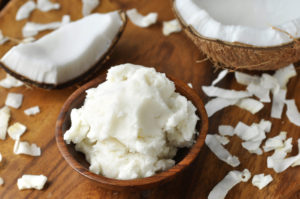
Milk has diuretic properties. It helps to improve the functioning of the kidneys and the central nervous system. It is recommended to drink milk to strengthen teeth and prevent their diseases. The liquid contains cytakines, which prevent the harm of cancer cell formation. Thanks to its healing properties, milk:
- has a rejuvenating effect;
- is a prophylactic agent for thrombosis;
- improves metabolism and digestion;
- strengthens the immune system;
- lowers cholesterol and blood sugar;
- normalizes pressure;
- prevents the development of atherosclerosis;
- helps to cure sore throats and other colds.
The health benefits of a young coconut are largely due to its water. It is found only in unripe nuts and is very different from milk in its sweet-sour taste and calorie content. It is an excellent thirst-quenching agent that has the beneficial properties of restoring water balance in the human body. Among its useful properties is the ability to eliminate infections in the bladder. In terms of composition, drupe water can be compared with saline.
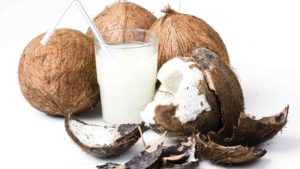
Great benefits of coconut water for delicate skin. It helps relieve lethargy, tones the skin, and stops age-related changes. In adolescence, it is used to treat acne.
Benefits of coconut for women
The benefits of coconut for a woman's body are unconditional. Its beneficial substances help to strengthen hair. Coconut enriches hair with nutrients and repairs it after damage. The beneficial properties of essential oils, milk, water and pulp are used in cosmetology. They are added to anti-aging masks, creams for dry skin, shampoos and rinses. Facial products smooth and prevent the harm of the appearance of age-related wrinkles and tone the skin.
Without harm, the health benefits of coconut for older women are significant. Its use in food improves the functioning of the urinary and reproductive systems, and also postpones the onset of menopause.
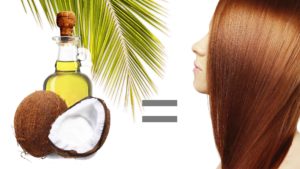
Why is coconut good for men
The benefit of coconut for a man's body is that it is a strong aphrodisiac and strengthens the reproductive system. Exote serves as a prophylactic agent for prostatitis and diseases of the urinary system. While coconut has health benefits for men, in some cases it can be harmful. Basically, this happens with individual intolerance to the product and obesity.
Can pregnant women eat coconut?
All parts of the plant have the benefits of coconut during pregnancy. Water and milk replenish fluid and nutrients in the body. The liquid parts of the drupe tend to relieve toxicosis, which manifests itself in the first three months of pregnancy.Eating a tropical treat can help relieve heartburn, nausea, and vomiting. Women often suffer from constipation before giving birth. The fruit helps to alleviate the condition by having a beneficial effect on the intestines.
Is coconut allowed for breastfeeding
Coconut is also useful for a nursing mother. The nut contains lauric acid, which has properties to enhance the immune system, improve the functioning of the central nervous system. It is an antiviral agent and helps fight infections. The delicacy of the tropics increases the nutritional value of milk and saturates it with vitamins and minerals that the baby receives during feeding.
At what age can children take coconut
The benefits of fresh coconut are significant for children too. The beneficial calcium it contains plays an important role in the development of a child's teeth and bones. The tropical nut contributes to the normal growth and development of the baby, saturates with energy and nutrients. Drupe oil is a gentle, natural remedy that can be used to care for delicate baby skin. But when introducing the product into the children's diet, it should be borne in mind that the child's stomach is very susceptible. Therefore, it is necessary to give exotic children from 1.5 - 2 years. If a child has an allergic reaction to any foods, it is better to delay or minimize the use of the fetus. Exotic fruits are recommended to be introduced into the children's diet from 3 years old, having checked for the absence of allergic reactions.
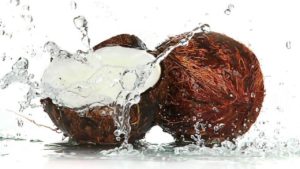
The benefits and harms of coconut for weight loss
The slimming benefits of coconut are enhanced by lauric acid, which is a key ingredient in weight loss. Among the properties of dodecanoic acid are present:
- the ability to burn excess fat;
- improving the processes of the digestive system;
- acceleration of metabolism;
- decreased hunger.
Due to its high calorie content, exotic tends to contribute to the rapid saturation of the body, but thanks to fiber, it does not gain excess weight. Vegetable fats are converted into energy and are not stored in the folds of fat.
Despite the benefits of coconut, harm from eating it is possible if there are health problems. Its excessive use can lead to a rise in cholesterol, disrupt the work of the heart and cause the appearance of pathologies. It is worth abandoning the product with intolerance to its components by the body and with obesity.
Features of the use of coconut for diabetes and gastritis
Diabetics should be careful when consuming coconut. You can add pulp to your diet in small amounts. The health benefits of coconut also include the fact that the manganese it contains lowers blood sugar. With diabetes, you can use exotic water, which tends to relieve fever. But sugar, butter and drupe milk should be discarded. These parts of the tropical fruit are incompatible with diabetes.
In case of stomach diseases, including gastritis and ulcers, it is recommended to consume milk and dairy products. For people who have an intolerance to this type of food, coconut milk is an excellent replacement option. It contains coarse fibers that have a positive effect on the digestive system and improve metabolic processes. Another useful property of tropical milk is its ability to normalize the intestinal microflora without harm to the digestive tract.
The exotic fruit has antibacterial properties, so it is recommended to be consumed by anyone with gastritis. But in case of an ulcer, it is necessary to introduce a moderate amount of the product so as not to overload the stomach.
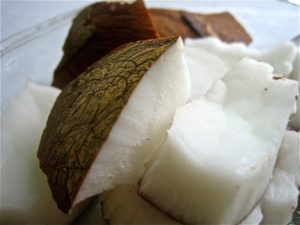
Application of coconut
Coconut is a unique product with a variety of unique properties that are used in various fields. Its fibers are used for the manufacture of twines, ropes, carpets.
The product is added to a substrate for flowers and plants intended for home growing.
The shell is used for making souvenir jewelry and dishes. It is an excellent material for making charcoal.
Coconut oil is considered one of the most valuable for cosmetic use: it is widely used to add to masks, face and body creams, shampoos and other hair products. In its pure form, it is used in massage parlors, including for the fight against cellulite.
In the culinary field, tropical delicacies are used to make desserts. The components of the drupe are added to baked goods. And pastry chefs create interesting decorations for cakes, rolls and other delicious products from coconut flakes.
How and with what to eat coconut
Thanks to its medicinal properties, taste and minimal potential for harm to health, a tropical delicacy is far from the last place in cooking. The addition of its healthy pulp makes appetizers, salads and main courses exotic. Fruit milk is used for the preparation of desserts, drinks, soups. Coconut is combined with poultry, especially chicken and rabbit. It is added to cereals. Seafood, potatoes and peppers go well with the fruit of the tropics. It is compatible with other exotic fruits, citrus fruits and strawberries. An interesting combination of coconut with spices turns out. And the combination with chocolate and caramel is used for the preparation of confectionery.
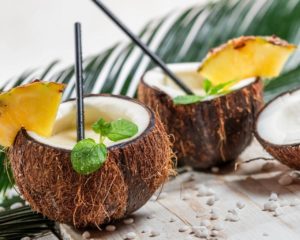
How to break a coconut at home
When starting to open the exotic, you need to prepare two knives: a small one and a large one with a wide blade.
Open as follows:
- Choose the most pronounced point.
- Pull it open with a small knife.
- Pour milk through the hole.
- While rotating the coconut, tap it with the flat side of a large knife blade for 1 to 2 minutes.
- After the crackling appears, continue tapping, turning the fruit around its axis until a crack appears.
When the crack widens, you can try cracking open the coconut by breaking it.
Video how to open a coconut
Possible harm to coconut and contraindications
If you do not overuse coconut, you do not have to worry about the possible harm from its use. The daily intake of exotics in grams:
|
For men |
300 |
|
For women |
200 |
|
For children from 3 to 10 years old |
50 — 100 |
Excessive use can cause hypervitaminosis. And because of the increased calorie content, there is a risk of gaining excess weight. You should refuse to introduce the product into the diet for personal intolerance. Diabetics need to completely avoid coconut milk.
How to choose the right coconut in the store
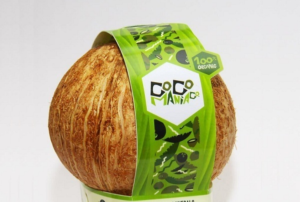
When purchasing coconuts, you should ask how long ago they were shipped. Then you need:
- Taste the fruit by weight: a high-quality coconut will be heavy with a small size.
- Shake the drupe. If at the same time gurgling and splashing is heard, then the nut is ripe. If nothing is heard, the liquid may have leaked due to possible damage during transportation or evaporated as a result of long-term storage.
- Examine the coconut for dents, cracks or other damage that could compromise the sterility of the edible parts of the nut and cause them to rot.
- Check if the points of the coconut are damaged during transport.
- A good quality nut must be dry.
When buying exotics, do not forget that excellent appearance cannot fully guarantee excellent taste.
How and where to store open coconut
The product of the tropics is not subject to long-term storage. A whole nut can be kept for no more than a month without losing its beneficial properties. The storage of an open coconut is 2 - 3 days, then it begins to ferment.
Milk should be used immediately after opening. You can store it for only a week by sealing the container with it.
The shelf life of the pulp is 7 days. In this case, it should be filled with water. Dried coconut flakes lend themselves to the longest storage. It can be kept for about a year by placing it in a cool dry place with the tightly closed.
Conclusion
The benefits and harms of coconut vary greatly.Correct use, taking into account contraindications, will strengthen health and fill the body with energy. The nut will help quench your thirst and hunger. And thanks to its origin, the fruit of warm countries will add exoticism to the festive table.

